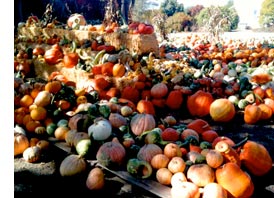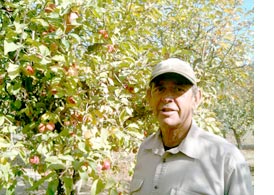Hale’s Apple Farm
- By FruitGuys Staff
- Reading Time: 3 mins.

In Fall, you can’t miss the explosion of roadside color that is Hale’s Apple Farm as you drive along Route 116 just north of Sebastopol, CA. The riot of piles of brilliant gourds can cause the unwary traveler to swerve. The best pull over for a better look. Orange and white pumpkins of all sizes; butternut, acorn, speckled swans, and turban squash are all artfully draped in trees or applied as humorous accents to antique farm equipment in front of the picture-perfect redwood barn.
This picturesque barn is the HQ for Dave Hale’s farm. Dave has been an apple farmer for 30 years in Sebastopol (Sonoma County), CA, and has seen the apple industry come and go over the years—mostly go. Falling apple prices, rising grape prices, and encroaching development have all contributed to the downsizing of small farms. In the old days, Dave used to farm 90 acres. Now he is down to 20.
 2010 was the straw that broke the camel’s back. Dave had worked hard for years growing apples for market and watching apple prices continue to drop until he could just make enough to pay his workers. The final blow came when a large corporate apple processor offered $125 a ton for his tree-ripened apples, that’s a puny 6 cents a pound. “That was it,” Dave recalled. “I said, ‘I’m done with corporations.’” Dave then cut back to direct sales: he only sells out of his farm stand (open August through November), the Palo Alto Farmers’ Market (where he has sold for 27 years), a few restaurants, and to “good companies like you guys” [The FruitGuys].
2010 was the straw that broke the camel’s back. Dave had worked hard for years growing apples for market and watching apple prices continue to drop until he could just make enough to pay his workers. The final blow came when a large corporate apple processor offered $125 a ton for his tree-ripened apples, that’s a puny 6 cents a pound. “That was it,” Dave recalled. “I said, ‘I’m done with corporations.’” Dave then cut back to direct sales: he only sells out of his farm stand (open August through November), the Palo Alto Farmers’ Market (where he has sold for 27 years), a few restaurants, and to “good companies like you guys” [The FruitGuys].
Want farm-fresh fruit?
We've got you covered.
Endangered Farmers
Apple farmers like Hale have become an endangered species in Sonoma County. Rising land values, vineyards replacing orchards, and cheap apple imports have driven his kind to the brink of extinction. Many farmers have had to supplement their orchard operations by turning over at least part of their land to grape growing. The maintenance cost is less and the price per ton is about 100 times higher than apples. In 1937, Sonoma County had an estimated 17,000 acres of apple orchards, the region’s growers boomed from supplying World War II troops with applesauce, but has declined ever since. Today there are just some 2,300 acres. The last 20 years have seen a vineyard boom for the county: about 60,000 acres worth.

“How can you compete?” Dave asks, holding up a $60 crate of beautiful red Rome apples. “When a box this size of wine goes for $200?”
Yet, wine grapes are for drinking, not eating. And Dave’s lovely apples are delicious eating. He grows Gravensteins, the hallmark apple of the region, but is famous for his Pink Pearl apple. The Pink Pearl has a surprise inside: flamingo pink flesh. He also grows Romes, one he has renamed “Sleeping Beauty” because so many people remarked that it looked like the apple in the fairy tale. “They would say Sleeping Beauty’s apple but meant the story of Snow White. People get their Disney mixed up,” Dave notes. This iconic red apple is the princess at his farm stand, crisp and sweet, with a bit of red striation inside.
Dave Hale proudly shows off the tree he’s going pick the next day for The FruitGuys. A lovely tree festooned with striped Rome apples. He snaps one off, polishing it on his shirt. Beyond his fence, rows of just-harvested grapevines can be seen with barren earth between.
Back at the barn, Dave straightens up buckets of sunflowers for sale, answers questions about gourds, and weighs apples for customers. One buys some fresh apple juice, shakes Dave’s hand and says, “Thanks for not growing grapes.”
“I get that a lot,” Dave says.
Want fruit for your office?
Get your office a free sample TODAY!
———
Hale’s Farm stand is open 9 a.m.–6 p.m. daily, August through Thanksgiving. 526 Gravenstein Hwy N., Sebastopol, CA 95472.


